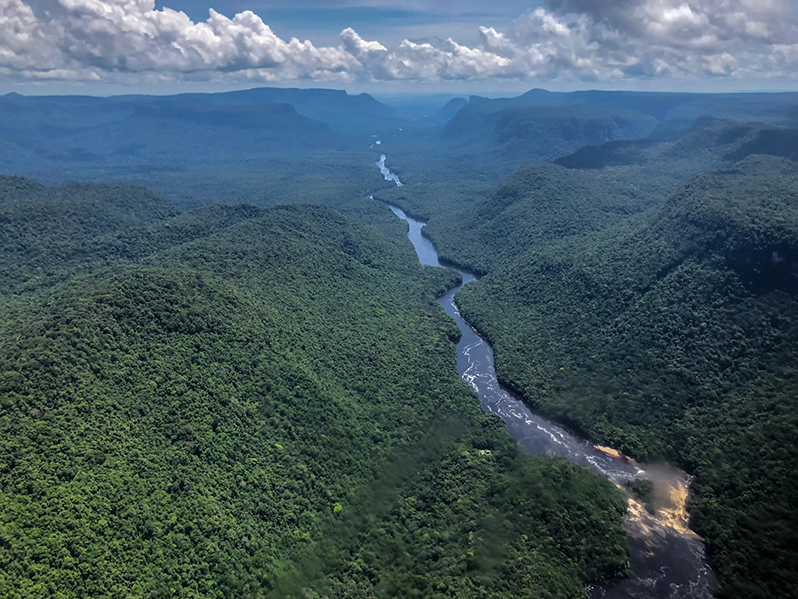THE Low Carbon Development Strategy (LCDS) for Guyana is a framework meant to reshape society to pursue low-carbon development while also attempting to maintain Guyana’s high forest cover.
Guyana’s LCDS is, therefore, a work in progress, developing a model that outlines Guyana’s viewpoint on how a platform for co-operation can be created in which developing countries are seen as equal partners in the search for solutions to the catastrophic effects of climate change.
According to President Irfaan Ali’s foreword to the LCDS, “despite our various differences, successive Guyanese governments of different parties have shown significant leadership to the world on the need to safeguard our forests.” However, it was the PPP/C government that catapulted the LCDS into the spotlight.
There is an agreement dated November 9, 1995, between the government of the Co-operative Republic of Guyana and the Commonwealth Secretariat for establishing the Iwokrama International Centre for Rain Forest Conservation and Development.

The innovative Iwokrama Rain Forest Programme, an internationally renowned conservation, research and development forest concession offered to the world by Guyana as an area to study and sustainably utilise the multiple values of a tropical rainforest, including sustainable forest management, ecosystem services, and resource co-management with neighbouring Indigenous Peoples communities which was proposed as one example of this trend.
Guyana’s United Nations Environment Programme (UNEP) envoy led the working group that prepared the 1992 Principles for a Global Consensus on the Management of the Earth Summit Mission to Rio de Janeiro.
Other social and economic development and environmental protection strategies include the National Development Strategy (NDS 2001) and the Environmental Protection strategies (competitiveness, poverty reduction, MDGs, the proposed National Protected Areas System, and the Biodiversity Action Plan, to name a few.
Through the Amerindian Act of 2006 and the Forest Bill of 2009, the LCDS also emerged from a recent history of multi-institutional policy development. This includes the 1980s Economic Recovery Programme, the 2001 National Development Strategy (NDS) and other social and economic development initiatives.
On June 8, 2009, the then President of Guyana and the current Vice President, Dr. Bharrat Jagdeo, launched the Low Carbon Development Strategy (LCDS). This national strategy aims to develop “a low-deforestation, low-carbon, climate-resilient economy.”
The main goal of that strategy is to transform Guyana’s economy while battling climate change, primarily by providing incentives to maintain forests, which are responsible that time for about one-fifth of all global emissions.
In 2009, the Vice President said in a quote, “The LCDS is a framework intended to map the path of a new growth trajectory in a non-polluting way. Tropical forest countries have long called for the ecosystem services provided by the world’s standing tropical forests to be properly valued through both public and private finance. This will enable people who live in forests and forest countries to create jobs and economic opportunity from an economy that works with nature instead of today’s reality, where forests are often worth more dead than alive.”
The international leadership paved the way to shaping an agreement that would support payments to rainforest countries such as Guyana for storing forest carbon in their standing forests under the Reducing Emissions from Deforestation and Forest Degradation(REDD) plus Sustainable Forest Management and Conservation mechanism.
The United Nations Framework Convention on Climate Change (UNFCCC) states that parties should act to protect the climate change system “on the basis of equality and in accordance with their common and differentiated responsibilities and perspective capabilities.”
Guyana has played a leading international role in broadening the vision of REDD+, moving away from payments solely contingent against a deforestation baseline towards more holistic low-carbon development investments for those countries with high forest cover and low deforestation rates (HFLD countries).
As a result, the REDD approach is a ground-breaking component of Guyana’s low-carbon development strategy, “transforming Guyana’s economy while combating climate change.”
The first phase of Guyana’s low carbon vision, where payments for forest climate services, were to come from a bilateral partner. It saw Guyana entering the Guyana-Norway Partnership in 2009. From 2009 to 2015, Guyana earned US$212.6 million in payments for forest climate services from Norway, which reached US$220.8 million when investment income was included. These revenues were invested in renewable energy, protection against climate change, land titling, job creation and other priorities in the original LCDS.
Crucially, Phase I saw Guyana building a world-class Monitoring, Reporting and Verification System (MRVS) for forest carbon, enabling Guyana to move to Phase II for selling forest climate services in voluntary carbon markets.
The period from 2016 to 2021 saw no payments for forest climate services under the Guyana-Norway Agreement. Still, Guyana’s MRVS continued to operate, allowing the generation of carbon credits for that period. These can be sold if a market can be accessed in Phase II.
This explains Guyana’s plan for encouraging climate-smart behaviour and preserving the ecosystem and biodiversity.
On December 2, 2022, Hess Corporation and the Government of Guyana announced an agreement for Hess to purchase high-quality carbon credits for a minimum of $750 million directly from the Government of Guyana.
This agreement will support Guyana’s efforts to protect the country’s vast forests and provide capital to improve the lives of Guyana’s citizens through investments made by the government as part of Guyana’s Low Carbon Development Strategy (LCDS) 2030.
Guyana’s President, Dr. Irfaan Ali was joined by Vice President, Dr Bharrat Jagdeo and John Hess, CEO of Hess Corporation, for a signing ceremony to commemorate this historic agreement.
(This is part of a weekly series on LCDS)
The author can be contacted at cparkinson0206@gmail.com




.png)









